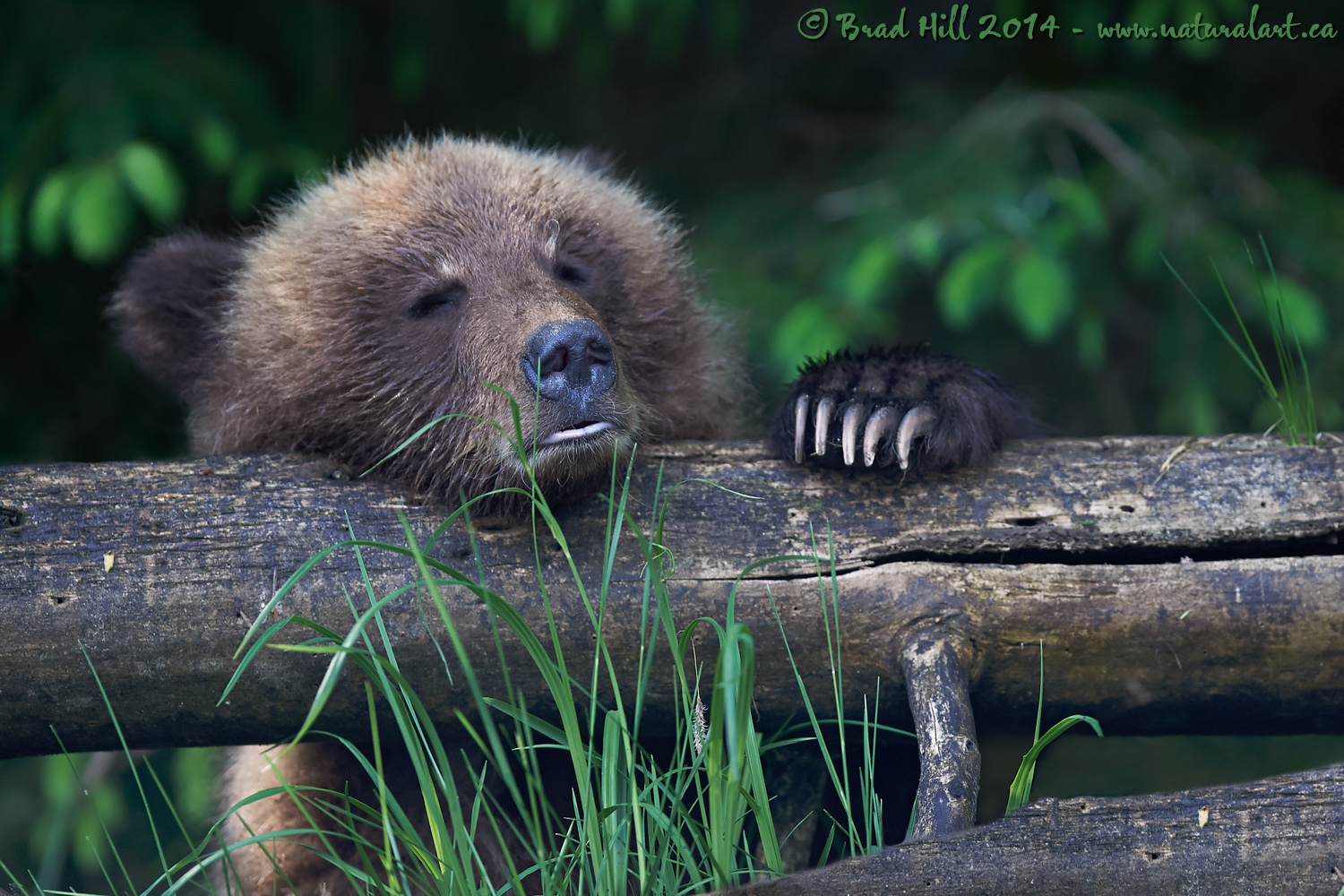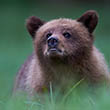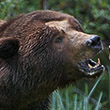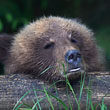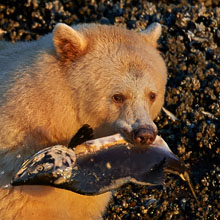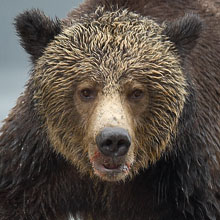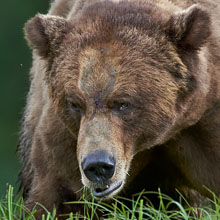Availability: Undetermined - Enquiries?
In the Field
Flat Out! Khutzeymateen Grizzly Sanctuary, northern BC coast (Great Bear Rainforest), Canada. June 1, 2014.
Like many young animals (and I'm not necessarily excluding humans), bear cubs have two speeds - flat out and...well...flat out! This is a shot of a yearling grizzly cub in the more sedate form of flat out. The process of this bear fading into dreamland was pretty interesting to watch - Ma had taken the bears off the shoreline (where they had been feeding for a few hours on clams) and junior found this great place for a salad dessert! The cub was able to completely rest his head (and left paw) on this log and munch away at the strands of grass with almost no effort. But it was obvious he/she was losing it - its eyes kept getting droopier and droopier and it started doing the "startled-as-its-head-and-paw-dropped" thing as it drifted off. And a few minutes later it was gone to the world! ;-)
While this was just a great photo op, a few things definitely added to the challenge of capturing the scene. The grasses in front of the cub's mouth were pretty much impossible to deal with in-camera (in terms of minimizing their possible "distraction-value"). It could probably be argued that because the grasses themselves were one of the main reasons the bear was where it was they're an integral part of the scene. But I'm sure some will consider them distractions nonetheless. Perhaps they are - it's truly an "eye of the beholder" thing. C'est la vie.
The background was even more challenging to deal with. Those super bright green "spots" behind the little bear are new growth on the branch ends of a conifer (a Sitka Spruce I think?) and they were really close to the cub. Of course, I could have cloned them out or dramatically desaturated them during post-processing, but not only is that not my preferred approach to photography, but I also kind of liked them - to me they carry some information about the season this was shot in (spring). BUT...I did want to de-emphasize them a little. So I decided to experiment a little with the depth-of-field in this shot. Given the cub was pretty content to stay put (my way of saying it was comatose!), I had the chance to shoot a bunch of shots, and I ended up shooting several bursts in a "DoF series", each at a narrower and narrower aperture. I started at f2.8 (I was shooting this with a 400mm f2.8 VR prime) and worked my way up to f11 (at full stop increments after f5.6). I guessed I would be happiest with the shots taken with wider apertures - somewhere in the f2.8 to f4 range. And, I was right - this one (taken at f2.8) was definitely my favorite of the bunch - even at f4 the background became way too busy for my liking, and by f8 the cute little cub definitely co-mingled WAY too much with all the other elements in the image and simply didn't stand out.
Narrower aperture telephotos lens and telephoto zooms (like the AF-S 80-400mm f4.5-5.6 zoom) have a lot of positives associated with them - including being much smaller, lighter and - consequently - easier to hand-hold and to travel with. But in this case the subject-isolating ability of my big, heavy 400mm f2.8 prime definitely proved its worth.
Did I go too thin in the DoF? It's likely hard to make a judgement on this based on the images available above, so here's a higher resolution (2400 pixel) version of it so you can decide:
• Flat Out! Download 2400 pixel image (JPEG: 1.8 MB)
NOTE 1: This image - in all resolutions - is protected by copyright. I'm fine with personal uses of it (including use as desktop backgrounds or screensavers on your own computer), but unauthorized commercial use of the image is prohibited by law. Thanks in advance for respecting my copyright!
NOTE 2: Like all wildlife images on this website, the subject is fully wild and completely unconstrained. Besides the potential impact of my presence, nothing has been done to intentionally alter or affect the ongoing behavior of the subject and, of course, there has been no use of any form of bait or other form of wildlife attractants (including vocalizations).
NOTE 3: This image was captured during one of my "Grizzlies of the Khutzeymateen" photo tour in the spring of 2014. Each year I offer trips into two different parts of the Great Bear Rainforest as well as one to photograph aquatic mammals and oceanscapes near the northern tip of Vancouver Island. And, in selected years, I also offer photo tours to locations to capture other highly sought-after subjects, such as various boreal owl species and wildlife of Canada's Arctic. Details about these trips can be found on the Photo Tours page of this website.
Behind the Camera
Flat Out! Khutzeymateen Grizzly Sanctuary, northern BC coast (Great Bear Rainforest), Canada. June 1, 2014.
Digital Capture; Compressed RAW (NEF) 14-bit format; ISO 400.
Nikon D4s paired with Nikkor AF-S 400mm f2.8 VR - hand-held from floating Zodiac. VR on in Normal mode.
1/500s @ f2.8; -1.0 stop compensation from "recommended" matrix-metered exposure setting.
At the Computer
Flat Out! Khutzeymateen Grizzly Sanctuary, northern BC coast (Great Bear Rainforest), Canada. June 1, 2014.
RAW Conversion to 16-bit TIFF, including first-pass/capture sharpening using Phase One's Capture One Pro. Three raw variants (different versions of a single raw capture) processed, differing by a total of 0.7 stops in exposure.
Further digital corrections on resulting 16-bit TIFF files using Adobe's Photoshop CC 2014 and Light Crafts LightZone. Photoshop adjustments included compositing (blending) of the three output files from the raw converter, further slight exposure adjustments/tweaks, and minor colour desaturation (to the cub's nose and greens throughout the image), and selective sharpening for web output. Final tweaking of tones performed using LightZone's "tonemapper" tool.
Conservation
Flat Out! Khutzeymateen Grizzly Sanctuary, northern BC coast (Great Bear Rainforest), Canada. June 1, 2014.
Ten percent of the revenue generated by this image will be donated to Raincoast*.
Species Status in Canada**: Special Concern (May 2002).
While Grizzly Bears (Ursus arctos) are not technically listed as "Endangered" in Canada, they have been extirpated from most of their historical range. Grizzly Bears are far more sensitive to intrusion/disturbance in their habitat than are Black Bears and are being increasingly forced into marginal habitat by human encroachment. The Great Bear Rainforest along the central and northern coast of British Columbia is one of the last strongholds of the Grizzly Bear in Canada, and even this population is coming under increasing pressure.
On December 18, 2017 the government of British Columbia banned grizzly hunting across the entire province. This major conservation victory came after decades of tireless work by many dedicated conservationists and ecologists and, most importantly, it reflects the opinion of the vast majority of British Columbians. And, it means that AT LEAST while the current government remains in power grizzlies are finally "safe" in British Columbia.
Now that we've at least temporarily won the battle to save grizzlies in BC, it's time to re-focus our efforts toward protecting ALL of BC's carnivores, including Gray Wolves, Black Bears, Cougars, Wolverines, and more! Simply put, there are no ecological, economic, or ethical arguments supporting the trophy hunting of carnivores.
In a great first step towards ending the hunting of carnivores throughout BC the Raincoast Conservation Foundation has developed a program designed to protect ALL carnivores within the Great Bear Rainforest. Details about this program can be found on this page on Raincoast's website. Check it out and, better yet, make a donation to help Raincoast purchase the remaining commercial hunting tenures in the Great Bear!
*The Raincoast Conservation Society (and Foundation) is an effective and efficient organization that has been fighting for protection of this unique habitat. If you are looking for a meaningful way to contribute to the conservation of this amazing ecosystem, Raincoast will provide maximal "bang" for your conservation dollars.
**as determined by COSEWIC: The Committee on the Status of Endangered Wildlife in Canada












